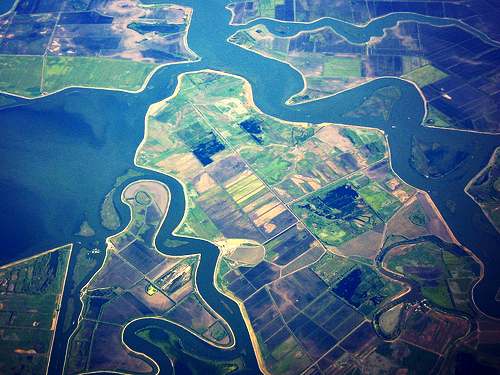By Jay Lund.
This is northern California’s wettest year of record, so far. The Yolo Bypass has been flooded for most of this wet season, and is still flowing. Are Delta water exports going to exceed the previous record exports from 2011 (6.5 maf)? The figure above compares this year’s Delta water exports compare with other years before and after the 2007 Wanger Decision, and the drought years (2012-2016).
So far, the State Water Project and Central Valley Project together have pumped a little less than in 2011, 2006 (another wet year), or 2007. They are all pretty close (with most of these highest-export water years falling after CVPIA and Endangered species restrictions on Delta pumping).
Compared to the drought years, the first two years of drought were less dry and exports were supplemented by water drawn from California’s large northern-of-Delta surface reservoirs. By 2014 and 2015, surface storage for drought exports was substantially depleted. This surface storage depletion partially refilled in 2016 and is now fully filled.
The State Water Project pumped at record daily rates in January, in the figure below. Daily maximum pumping was 10,426 cfs on February 2, exceeding the 8,500 cfs daily maximum from 2006-2016 and even Banks Pumping Plant’s listed capacity of 10,300 cfs. This compares to several hundred thousand cfs of Delta outflow during January.

Harvey O. Banks Pumping Plant. SF Chronicle Graphic by John Blanchard.
State Water Project pumping began to plummet as San Luis Reservoir filled and damage was found at the intake to the pumping plant’s Clifton Court Forebay. State Water Project pumping will be curtailed or stopped until this is repaired, with deliveries made good from San Luis Reservoir. Spring is likely to remain wet, with substantial additional pumping later in the season.
Finding places to store pumped water south of the Delta is becoming difficult. MWD of Southern California has reduced its use of Colorado River water to employ and store this Northern California abundance. About half of recent pumping has gone to filling San Luis Reservoir, which is essentially full. The San Joaquin and Tulare basins are also wet, filling reservoirs locally and likely helping refill some of the region’s drought-depleted groundwater.
It may be worthwhile to invest in additional groundwater or surface storage, water infiltration capacity, and conveyance to places with more infiltration capacity. But justifying such expensive decisions requires more economic calculations. For now, water managers throughout California are trying to avoid flooding, while maximizing the capture of flows for surface and groundwater storage.
Damage to the Clifton Court Forebay and lack of south-of-Delta storage (or conveyance to storage) are likely to keep this record-wet year from becoming a record Delta export year. Recent SWP and CVP water allocations are not yet at 100% for all contractors, but will likely increase, and seem limited mostly by conveyance and storage infrastructure this year. But for water users statewide, it is a welcome very wet year nonetheless.
This year is testing California’s water system in wet extreme conditions – for floods and capture of “surplus” flows, following five years of drought testing. For California water, every year is a test. Every year’s tests identify problems and opportunities. Hopefully learn from these tests.
Jay Lund is the Director of the Center for Watershed Sciences and a Professor of Civil and Environmental Engineering at the University of California – Davis. He is grateful that the people of California pay him.






